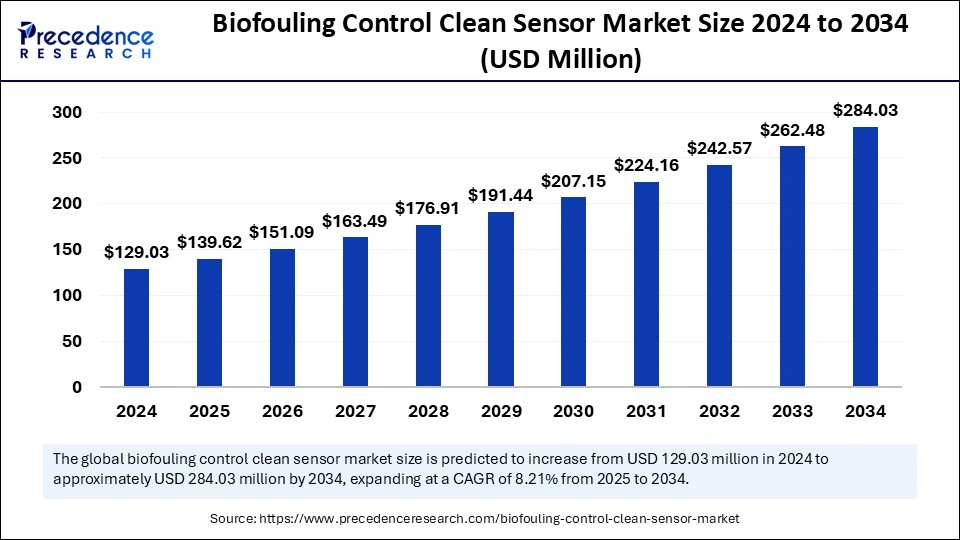Biofouling Control Clean Sensor Market Growth Set to Achieve USD 284.03 Mn by 2034
Biofouling control clean sensor market forecast shows growth from USD 129.03 Mn in 2024 to USD 284.03 Mn by 2034, driven by a CAGR of 8.21%.

Biofouling Control Clean Sensor Market Key Takeaways
Asia Pacific led the global biofouling control clean sensor market with the largest share in 2024.
Europe is projected to witness the highest CAGR during the forecast period.
The electrochemical fouling control system sensor segment dominated the market by type in 2024.
The marine engineering segment accounted for the largest share by application in 2024.
The industrial production segment is expected to grow at the fastest CAGR throughout the projection period.
Biofouling Control Clean Sensor Market Overview
The biofouling control clean sensor market is poised for significant growth as industries recognize the importance of maintaining sensor accuracy and reliability in critical applications. Biofouling, which results from the accumulation of organic matter on sensor surfaces, can compromise sensor performance and lead to erroneous data collection. To address this challenge, biofouling control technologies such as advanced coatings, UV sterilization, and electrochemical cleaning methods are being widely adopted across industries such as marine exploration, water treatment, and industrial automation.
The integration of artificial intelligence and machine learning in biofouling control systems is enhancing the effectiveness of these solutions by enabling real-time monitoring and adaptive response to environmental changes. The increasing demand for reliable sensor systems in applications such as aquaculture, offshore energy, and environmental monitoring is driving market growth and innovation.
Drivers
The growing emphasis on operational efficiency and data accuracy is a key driver of the biofouling control clean sensor market. Industries that rely on sensor systems for critical operations are increasingly adopting biofouling control solutions to prevent signal degradation and maintain optimal sensor performance. The rising deployment of sensor systems in aquaculture, marine research, and industrial automation is further fueling demand for biofouling-resistant technologies. Regulatory mandates promoting sustainable marine practices and the reduction of environmental impact are also driving the adoption of biofouling control solutions.
The integration of IoT and smart sensor networks in industrial and environmental applications is creating additional demand for biofouling prevention technologies that ensure consistent data collection and analysis.
Opportunities
The biofouling control clean sensor market presents significant opportunities for innovation and growth in areas such as smart water management, underwater robotics, and renewable energy. The development of advanced anti-fouling coatings and bio-inspired materials is enhancing sensor performance and extending operational lifespan. The increasing use of IoT devices and wireless sensor networks in environmental monitoring and industrial automation is driving demand for biofouling-resistant sensor systems.
Additionally, the adoption of predictive maintenance and condition-based monitoring technologies is enabling organizations to optimize sensor performance and reduce operational costs. The emergence of electrochemical cleaning methods and UV-based disinfection systems is further expanding the application potential of biofouling control technologies.
Challenges
The biofouling control clean sensor market faces challenges related to cost, technology integration, and long-term effectiveness. Developing and implementing advanced biofouling prevention technologies requires significant investment, which may be a barrier for small and medium-sized enterprises. Ensuring the long-term effectiveness of anti-fouling coatings and maintaining sensor performance in harsh environmental conditions is another challenge that requires ongoing research and innovation. Integrating biofouling control technologies with existing sensor systems can be complex and may require specialized expertise, increasing operational costs and complexity.
Regional Insights
North America dominates the biofouling control clean sensor market, driven by strong investments in marine research, environmental monitoring, and industrial automation. The United States, in particular, is a major contributor to market growth, with the widespread adoption of biofouling prevention technologies in sensor systems. Europe is another significant market, with countries such as Germany, the United Kingdom, and Norway promoting the use of biofouling control solutions to support sustainable marine practices. The Asia Pacific region is experiencing rapid growth, driven by increasing investments in aquaculture, offshore energy, and environmental monitoring projects.
China, Japan, and South Korea are leading market expansion in the region through the adoption of advanced sensor technologies and biofouling prevention solutions. Latin America and the Middle East & Africa are gradually adopting biofouling control technologies, supported by growing awareness of the benefits of clean sensor systems in industrial and environmental applications.
Recent Developments
Recent developments in the biofouling control clean sensor market include the introduction of nanotechnology-based anti-fouling coatings that provide long-lasting protection against biofilm formation. The integration of artificial intelligence and machine learning in biofouling prevention systems is enabling real-time data analysis, predictive maintenance, and adaptive response to changing environmental conditions.
Strategic partnerships between sensor manufacturers and research institutions are fostering the development of innovative biofouling control solutions. The adoption of electrochemical cleaning methods and UV-based sterilization technologies is enhancing the effectiveness and reliability of biofouling control systems.
Biofouling Control Clean Sensor Market Companies
- EVAC Group
- Yokogawa Electric Corporation
- ABB Ltd.
- KROHNE Group
- Veolia Water Technologies
- ALVIM SRL
- Sea-Bird Scientific
- ANB Sensors
- Green Eyes
- AML Oceanographic
- RBR Ltd
- Hydrolab
- Aanderaa
Segments Covered in the Report
By Type
- Electrochemical Fouling Control System Sensor
- Stoichiometric Fouling Control System Sensor
By Application
- Marine Engineering
- Aquaculture
- Industrial Production
- Others
By Geography
- North America
- Europe
- Asia Pacific
- Middle East & Africa
Ready for more? Dive into the full experience on our website!
